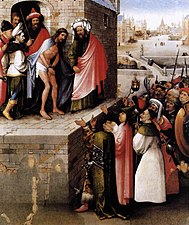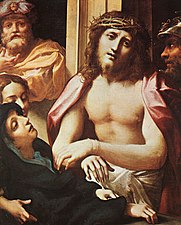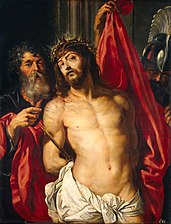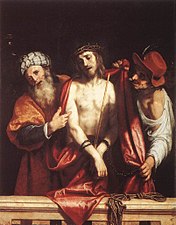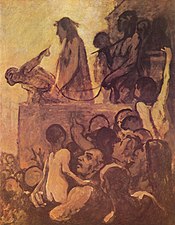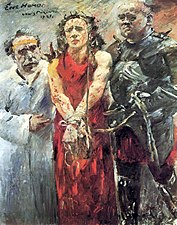Ecce homo

Ecce homo (
A scene of the ecce homo is a standard component of cycles illustrating the Passion and life of Christ in art. It follows the stories of the Flagellation of Christ, the crowning with thorns and the mocking of Jesus, the last two often being combined:[b] The usual depiction shows Pilate and Jesus, a mocking crowd which may be rather large, and parts of the city of Jerusalem.
But, from the 15th century in the West, and much earlier in the art of the Eastern church,
Eastern Christianity
Narrative scenes of the biblical moment are almost never shown in Eastern art, but icons of the single figure of the tortured Christ go back over a millennium, and have sometimes been called Ecce homo images by later sources. The first depictions of the ecce homo scene in the arts appear in the 9th and 10th centuries in the Syrian-Byzantine culture of the Antiochian Greek Christians.[g]
The icon presents the bridegroom as a suffering
The daily
A Passion Play, presented in Moscow (27 March 2007) and in Rome (29 March 2007), recalls the words, with which "in Holy Scriptures Christ describes Himself as a bridegroom":[m]
The Bridegroom of the Church is transfixed with nails.
The Son of the Virgin is pierced with a spear.
We venerate Thy Passion, O Christ.
We venerate Thy Passion, O Christ.
We venerate Thy Passion, O Christ.
Show us also Thy glorious Resurrection.— Hilarion Alfeyev, The Passion according to St. Matthew[18]
Western Christianity
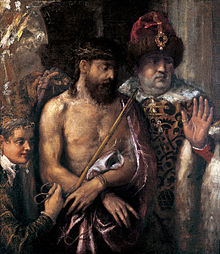
Depictions of

The motif found increasing currency as the
The motif of the lone figure of a suffering Christ who seems to be staring directly at the observer, enabling him/her to personally identify with the events of the Passion, arose in the late Middle Ages. At the same time similar motifs of the Man of Sorrow and Christ at rest increased in importance. The subject was used repeatedly in later so-called old master prints (e.g. by Jacques Callot and Rembrandt), in the paintings of the Renaissance and the Baroque, as well as in Baroque sculptures.
In 1498, Albrecht Dürer depicted the suffering of Christ in the ecce homo of his Great Passion in unusually close relation with his self-portrait, leading to a reinterpretation of the motif as a metaphor for the suffering of the artist. James Ensor used the ecce homo motif in his ironic painting Christ and the Critics (1891), in which he portrayed himself as Christ.
Antonio Ciseri's 1871 Ecce Homo portrayal presents a semi-photographic view of a balcony seen from behind the central figures of a scourged Christ and Pilate (whose face is not visible). The crowd forms a distant mass, almost without individuality, and much of the detailed focus is on the normally secondary figures of Pilate's aides, guards, secretary and wife.

One of the more famous modern versions of the ecce homo motif was that by the Polish artist
Especially in the 19th and 20th centuries, the meaning of ecce homo motif has been extended to the portrayal of suffering and the degradation of humans through violence and war. Notable 20th-century depictions are
Artworks
These are images of the narrative type, with other figures, rather than the devotional Man of Sorrows type.
- Ecce Homo (Bosch, 1470s), now Frankfurt
- Ecce Homo (Bosch, 1490s), follower of Bosch, now Indianapolis and Philadelphia
- Ecce homo (Mantegna), c. 1500, now Paris
- Ecce Homo (Caravaggio), c. 1605, Genoa
- Ecce Homo (Rubens), c. 1612 Hermitage Museum
- Ecce Homo (Luini), before 1532, Cologne
- Ecce Homo (Daumier), 1850, Essen
Gallery
-
Ecce Homo, Nuno Gonçalves, 15th century
-
Hieronymus Bosch, 1470s
-
Ecce Homo, Abraham Janssens, (1567–1632)
-
Correggio, 16th century
-
Tintoretto, 1546
-
Ecce Homo, by Titian (1490–1576)
-
Ecce Homo byAndrea Solario, c. 1506
-
Quentin Massys, c. 1520
-
Rubens, 1612
-
Jan Cossiers, c. 1620
-
Mateo Cerezo, 1650
-
Ecce Homo, by Lodovico Cardi called Cigoli
-
Ecce Homo, by Philippe de Champaigne (1602–1674)
-
Ecce Homo, by Elias Moskos, 1648
-
Ecce Homo, by Pedro de Mena, 17th century
-
The statue of Ecce Homo, revered in Brazil as the Good Jesus
-
Ecce Homo, by Pierre Mignard, (1690)
-
Ecce Homo, by Honoré Daumier, (1850)
-
Antonio Ciseri (1871)
-
Ecce Homo, byAdam Chmielowski, 1879–1881
-
Lovis Corinth, 1925
Publications
- Хальфан, Елена (30 March 2009). "Se Zhenikh gryadet v polunoshchi..." Се Жених грядет в полунощи... [Behold, the Bridegroom comes at midnight...]. Pravmir.ru (in Russian). Moscow: Orthodoxy and the World. Archived from the original on 14 February 2018. Retrieved 28 March 2019. — Rotem (29 December 2018). "Church of Holy Sepulchre: Greek Orthodox Calvary". BibleWalks.com. Holy Land sites review. Archived from the original on 10 February 2019. Retrieved 28 March 2019.
- ISBN 978-1-68245-073-4.
- "Christ The Bridegroom: 'Behold, the Bridegroom is coming...'". Byzantine Catholic Eparchy of Parma: Christ the Bridegroom Monastery. April 2009. Archivedfrom the original on 1 August 2018. Retrieved 3 April 2019.
- Moscow Patriarchate. Archivedfrom the original on 1 December 2008. Retrieved 22 March 2019.
- John El Massih (10 April 2017). "Bridegroom, Troparion" (Sheet music) (in English and Arabic). Antiochian Orthodox Christian Archdiocese of North America — Sacred Music Library. Archived from the original on 19 April 2019. Retrieved 19 April 2019.
- Basil Essey (14 February 2008). "Bridegroom, Exaposteilarion" (Sheet music). Antiochian Orthodox Christian Archdiocese of North America — Sacred Music Library. Archived from the original on 19 April 2019. Retrieved 19 April 2019.
- "Christus der Bräutigam" [Christ the Bridegroom] (JPEG image). 4 April 2018. Archivedfrom the original on 1 April 2019. Retrieved 2 April 2019.
- "Christus der Bräutigam" [Christ the Bridegroom] (JPEG image). 4 April 2018b. Archivedfrom the original on 1 April 2019. Retrieved 2 April 2019.
- "Gemeinde Wien" [Parish of Vienna] (in German). Antiochenisch-Orthodoxe Metropolie von Deutschland und Mitteleuropa. 2019. Archived from the original on 1 April 2019. Retrieved 1 April 2019.
- Alexandre (Semenoff-Tian-Chansky) (1984). Catéchisme orthodoxe (in French). Translated by Rovère, Irène (3rd ed.). Paris: BnF 34859890h. ASIN B0014P88QS (1961. 1st ed.). ASIN B0014P9SHG (1966. 2nd ed.). — Александр (Семёнов-Тян-Шанский). "O dukhovnoy zhizni khristianina. Khristianskaya etika: Pritchi o Samom Spasitele" О духовной жизни христианина. Христианская этика: Притчи о Самом Спасителе [On the spiritual life of a Christian. Christian ethics: Parables about the Savior Himself]. Pravoslavnyy katekhizis Православный катехизис [Orthodox catechism] (in Russian). Archived from the original on 1 February 2017. Retrieved 29 March 2019.)
{{cite book}}:|website=ignored (help - Slobodskoy, Serafim Alexivich (1967). The Law of God: For Study at Home and School (English translation). Translated by '25 December 2005 / 7 January 2006'.
- "Church Of All Russian Saints in Burlingame, CA". Burlingame, CA]. Doroga domoy k nashemu Ottsu Gospodu Bogu i materi Tserkvi Дорога домой к нашему Отцу Господу Богу и матери Церкви [The Way Home to our Father, the Lord God, and Mother Church] (in Russian). 15 September 2008 [31 May 2002]. Archivedfrom the original on 27 August 2018. Retrieved 7 April 2019.
- "Behold, the Bridegroom cometh at Midnight" ( from the original on 4 April 2019. Retrieved 4 April 2019.
- "Bases of the Social Concept of the Russian Orthodox Church". Department for External Church Relations. Moscow Patriarchate. 16 August 2000. Archivedfrom the original on 24 July 2008. Retrieved 22 March 2019.
- Moscow Patriarchate. Archivedfrom the original on 27 August 2008. Retrieved 22 March 2019.
- ISBN 3-579-04136-3.
- Krén, Emil; Marx, Daniel. "Ecce Homo by BOSCH, Hieronymus". Web Gallery of Art. Archived from the original on 4 November 2016. Retrieved 18 March 2019.
- Wójtowicz, Marek (3 May 2011) [29 April 2011]. "Papież nowej ewangelizacji" (in Polish). DEON.pl. Archived from the original on 10 July 2017. Retrieved 18 March 2019.
- Muzeum Okręgowe w Bydgoszczy im. Leona Wyczółkowskiego. Archivedfrom the original on 12 March 2016. Retrieved 18 March 2019.
- ISBN 978-3-499-25684-4.
- Wicks, Robert J. (8 May 2017). "Nietzsche's Life and Works". In Zalta, Edward N. (ed.). Stanford Encyclopedia of Philosophy.
See also
References
- ^ a b Хальфан 2009; Rotem 2018.
- ^ Dreher 2017, p. 187.
- ^ Alfeyev 1995.
- ^ "Holy Week: An Explanation". Antiochian Orthodox Christian Archdiocese of North America. Archived from the original on 10 August 2018. Retrieved 19 April 2019.
- ^ Basil Essey 2008.
- Facebook
- ^ Christus der Bräutigam 2018; Christus der Bräutigam 2018b; Gemeinde Wien 2019.
- ^ Slobodskoy 1967, "Short Prayers: Another Prayer to the Lord Jesus" - Archived 7 August 2018 at the Wayback Machine; Слободской 1967, "Kratkiye molitvy: Yeshche odna molitva Gospodu Iisusu - Краткие молитвы: Еще одна молитва Господу Иисусу" -Archived 27 August 2018 at the Wayback Machine.
- ^ The Way Home 2008; Дорога домой 2008.
- ^ John El Massih 2017; Christ the Bridegroom Monastery 2009.
- ^ ها هو ذا الختن on YouTube
- JPEG image). Orthodox Church in America. Archivedfrom the original on 30 March 2019. Retrieved 15 May 2019.
- ^ Alexandre (Semenoff-Tian-Chansky) 1984.
- ^ Slobodskoy 1967, "The Order of Divine Services: The Daily Cycle of Divine Services". Archived 8 June 2017 at the Wayback Machine; Слободской 1967, "O poryadke tserkovnykh Bogosluzheniy: Sutochnyy krug Bogosluzheniy" О порядке церковных Богослужений: Суточный круг Богослужений. Archived 7 August 2018 at the Wayback Machine.[e]
- ^ Slobodskoy 1967, "The Sundays of Lent: Passion Week". Archived 8 June 2017 at the Wayback Machine; Слободской 1967, "Nedeli Velikogo Posta: Strastnaya sedmitsa" Недели Великого Поста: Страстная седмица. Archived 6 August 2018 at the Wayback Machine.[e]
- ^ Russian chant 2010.
- ^ Bases of the Social Concept 2000.
- ^ Alfeyev 2007.
- ^ Schiller 1972, pp. 74–75, figs. 236, 240, 256–273.
- ^ Krén & Marx.
- ^ Wójtowicz 2011.
- ^
 Media related to File:Church of Saint Albert Chmielowski (Ecce Homo Sanctuary) in Cracow, Poland.jpg at Wikimedia Commons.
Media related to File:Church of Saint Albert Chmielowski (Ecce Homo Sanctuary) in Cracow, Poland.jpg at Wikimedia Commons.
- ^ Wyczółkowski 1880.
- ^ Grosz 2011.
- ^ Christ the Bridegroom Monastery 2009.
- ^ Wicks 2017.
Notes
- ^
- ^ NA28), illudebant ei (NVUL), lit. 'they mocked him' […]. — "The reed is a Christian symbol of humility […]. After whipping Christ and crowning him with thorns, the Roman soldiers gave Christ a reed as pathetic scepter for a mock ruler. In Christian iconography, the reed is a sign of Jesus's willingness to suffer humiliation to fulfill the will of his Father. […] [T]he humility is the absolute requirement for advancement in the spiritual life."[2]
- Acts 11:26)'"
- ^ "At the first service of Palm Sunday evening, the priest carries the icon of Christ the Bridegroom in procession, and we sing the 'Hymn of the Bridegroom'. We behold Christ as the Bridegroom of the Church, bearing the marks of His suffering, yet preparing a marriage Feast for us in God's Kingdom. […] The Parable of the Ten Virgins is read on Holy Tuesday. […] The theme of the day is reinforced by the expostelarion hymn we sing:"[4][5]
I behold Thy bridal chamber
richly adorned,
O my Savior;
but I have no wedding garment
to worthily enter.
Make radiant
the garment of my soul,
O Giver of Light,
and save me. - ^ Internet editionat Dorogadomoj.com.
- ^ a b "Realizing our sinfulness and not relying on the power of our own prayers, in this prayer we ask […] the Mother of God, Who has special grace to save us sinners by Her intercession for us before Her Son, to pray for us sinners before our Saviour." (Russian: "Сознавая свою греховность и не надеясь на силу молитв своих, мы в этой молитве просим помолиться о нас грешных, пред Спасителем нашим, […] Божию Матерь, имеющую особенную благодать спасать нас грешных Своим заступничеством за нас перед Сыном Своим.")[8].[e][9]
- Eastern Orthodox Christianity in Syria is not to be confused with Syriac Christianity: "The Syrian Church has never had its own tradition of icon-painting. […] As to the non-Chalcedonian Orient, in particular the Church of Syria, icons did not find much acceptance there, and the churches were adorned with ornaments rather than icons."[3]
Antiochian representatives:[c]
- "Official motto" (JPEG image). The Antiochian Diocese of Los Angeles and the West. Archivedfrom the original on 24 February 2018. Retrieved 3 April 2019.
- "Christ the Bridegroom" (JPEG image). The Antiochian Diocese of Los Angeles and the West. Archived from the original on 11 June 2016. Retrieved 1 April 2019.[d]
- "Das Bräutigam-Gebet" -"The Bridegroom Prayer" on Facebook (Vienna – Austria.'[7][f]
Behold, the Bridegroom cometh at midnight,
ها هوذا الختن يأتي في نصف الليل
and blessed is the servant
فطوبى للعبد
whom he shall find awake.
الذي يجده مستيقظا،
But he whom he shall find neglectful
أما الذي يجده متغافلا فهو
is verily unworthy.
غيرمستحق.
Behold, therefore, O my soul, beware,
فانظري يا نفسي
lest thou fallest in deep slumber,
ألا تستغرقي في النوم
and the door of the kingdom
ويغلق عليك خارج
be closed against thee,
الملكوت
and thou be delivered to death.
وتسلمي إلى الموت،
But be thou wakeful, crying:
بل كوني منتبهة صارخة :
Holy, holy, holy art thou, O God.
قدوس قدوس قدوس أنت يا الله،
Through the intercessions of the Theotokos,
من أجل والدة الإله
have mercy on us.
ارحمنا.[10][11]
- "Official motto" (
- ^ Even if the icon inscription is Behold the Man.[12]
- ^ a b c "The icon of Christ the Bridegroom portrays the selfless love for Christ's Bride, the Church (Isaiah 54). He is dressed in royal colors as the betrothed King, complying with Sacred Scripture's account of His mockery by the Roman guards before His crucifixion. The crown is a symbol of His marriage to the Church; the rope, a symbol of bondage to sin, death and corruption which Jesus untied by His death on the Cross; the reed, a symbol of His humility."[25]
- ^ Russian: "Христос открывает Себя Носителем высшей радости", romanized: Khristos otkryvayet Sebya Nositelem vysshey radosti, lit. 'Christ reveals Himself as the Bearer of the highest joy'.[13]
- ^ Matthew 9:15; 25:1–13; Mark 2:19; Luke 5:34–35, 12:35–36. "[T]he Church is presented as His wife and bride": John 2:9–10, 3:29, Ephesians 5:24–27; Revelation 21:9.[17]
- romanized: IesoũS CHristóS ho nymphíos, lit. 'Jesus Christ the bridegroom'. — An icon, on the apex of the Rock of Calvary inside the Church of the Holy Sepulchre, under the Greek Orthodox altar of the crucifixion (12th Station of the Via Dolorosa).[1]
- ^ "[F]inal autobiographical statement" by Friedrich Nietzsche. "He begins this fateful intellectual autobiography—he was to lose his mind little more than a month later—with three eyebrow-raising sections entitled, 'Why I Am So Wise', 'Why I Am So Clever', and 'Why I Write Such Good Books'."[26]
- theme tune of the TV sitcom Mr. Bean.
- ^ Macaronic Latin / Ecce Mono (Spanish for 'Behold the monkey'). Exemplary of an accidental damage of art.
Further reading
- Baxter, Roger (1823). . Meditations For Every Day In The Year. New York: Benziger Brothers.
- Prezzia, Paul Joseph (18 April 2019). "Glory to You, Love: Puccini's Turandot and the Triduum". from the original on 18 April 2019. Retrieved 19 February 2019.
Christ speaks to us hardhearted men and women with these words: 'How beautiful art thou, my love, how beautiful art thou!' (Song of Solomon 4:1) Beauty, in physical terms, is the way the heavenly bridegroom speaks of love. And if Christ seeks us for the beauty He Himself created in us, and in spite of our cold hearts, He is under the obligation set for suitors in Sacred Scripture: 'A man shall leave father and mother, and cleave to his wife.' (Genesis 2:24)

![ΙϹ ΧϹ Ό ΝΥΜΦΊΟϹ[n][i]](http://upload.wikimedia.org/wikipedia/commons/thumb/5/57/5208-20080122-1255UTC--jerusalem-calvary.jpg/166px-5208-20080122-1255UTC--jerusalem-calvary.jpg)

